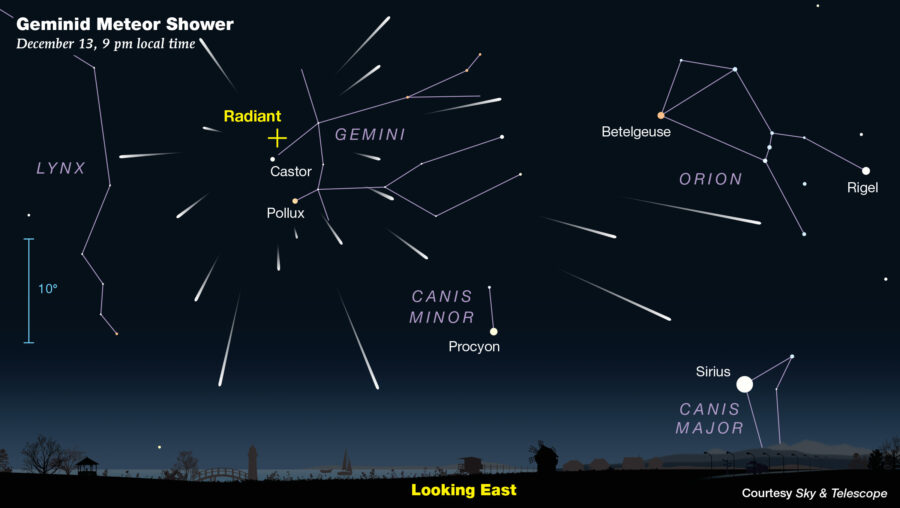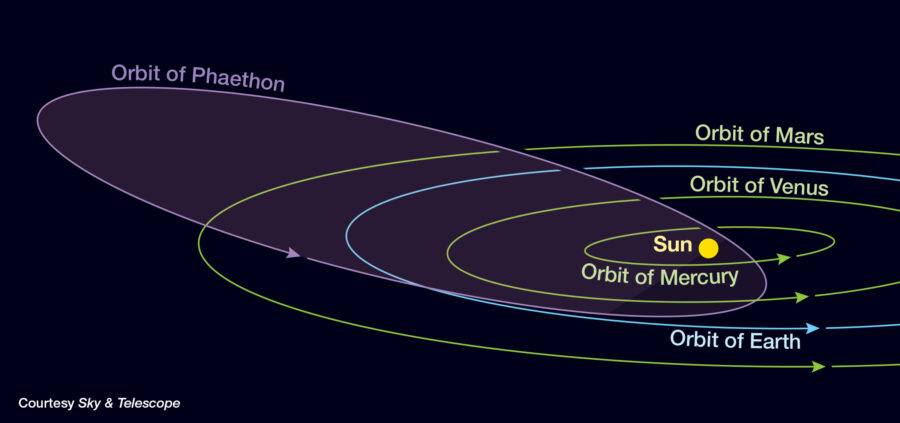Don’t miss the best meteor shower of the year. Catch the Geminid meteors as they peak on the moonless night of December 13–14.
Contacts:
Diana Hannikainen, Observing Editor, Sky & Telescope
+1-855-638-5388 x22100, [email protected]
Gary Seronik, Consulting Editor, Sky & Telescope
[email protected]
Rick Fienberg, Press Officer, American Astronomical Society
+1-202-328-2010 x116, [email protected]
Note to Editors/Producers: This release is accompanied by high-quality graphics; see the end of this release for the images and links to download.
On Sunday night, December 13th, and continuing into the early hours of Monday the 14th, be sure to head outside and look up — you may very well see brief streaks of light crossing the sky from the annual Geminid meteor shower.
Although the Perseids, which arrive every August, are better known, the Geminids usually put on a better show. “It’s worth braving the cold during this shower’s peak,” says Diana Hannikainen (pronounced HUHN-ih-KY-nen), observing editor at Sky & Telescope. “The Geminids offer the best display of ‘shooting stars’ all year.”
Sky & Telescope predicts that the Geminids should peak around 8 p.m. EST (5 p.m. PST) on December 13th, making this an ideal event for families to enjoy together since kids won’t have to miss their bedtimes by too much. In addition, the Moon will be new on December 14th, which means its light won’t wash out the fainter meteors.
The shower’s radiant — the spot in the sky from which all Geminid meteors appear to emanate — is near the relatively bright star Castor in the constellation Gemini. For viewers at mid-northern latitudes, the radiant is well above the eastern horizon by around 9 p.m. local time on December 13th. The radiant will stand highest at 2 a.m. local time on December 14th, which is ideal viewing time for those who can stay out late. Even though the peak has already occurred, meteor numbers should increase significantly after midnight, since that’s when Earth plows directly into the meteoroid stream.
The number of meteors you see will depend very much on the darkness of your location, and what time you’re out looking. “If you’ve got a clear, dark sky with no light pollution, you might see a meteor streak across the sky every minute or two from 10 p.m. until dawn on the night of the peak,” says Hannikainen.
The shower’s maximum is broad, with lower counts on the nights preceding and following the peak. Fainter meteors are more abundant ahead of the peak, brighter ones after the peak. So should the night of December 13–14 be cloudy, it’s worth casting your gaze skyward the night before and after the peak, when you could pick up around 30 or 15 meteors per hour, respectively.
How to Watch for Geminids
Meteor-watching is easy — you need no equipment other than your eyes. But you'll see more of them if you allow at least 20 minutes after going outside for your eyes to adapt to the darkness. Find a dark spot with an open view of the sky and no glaring lights nearby. Bundle up as warmly as you can in many layers. “Go out in the evening, lie back in a reclining lawn chair, and gaze up into the stars,” advises Hannikainen. “But as always, it’s good to remember to be patient. And bundle up!”
Geminids can appear anywhere in the sky, so the best direction to watch is wherever your sky is darkest, probably straight up. Small particles create tiny, quick streaks. The occasional bright one might leave a brief train of glowing smoke. The few that you may see early in the evening will make longer, dramatic trails, continuing for a few seconds as they graze sideways through Earth's uppermost atmosphere.
The Source of the Geminid Meteors
The last major meteor shower of the year is brought to us courtesy of 3200 Phaethon (FAY-uh-thon), a unique asteroid referred to as a rock comet since it shares characteristics with both asteroids and comets. The Geminids were first reported in 1862 and have been recognized as an annual phenomenon since then, but the source of the shower was unknown until Phaethon was discovered in 1983.
Phaethon is small, only about 3 miles (5 kilometers) across, and it loops around the Sun every 1.4 years in an orbit that approaches the Sun closer than any other named asteroid. It sheds rocky dust, rather than the ice-related vapors typical of comets, every time it nears the Sun, which heats its surface to roughly 1300°F (700°C). The dusty debris is about the size of sand grains to peas.
Over the centuries, these bits of Phaethon have spread all along the asteroid’s orbit to form a sparse, moving “river of rubble” that Earth passes through in mid-December every year. When we encounter these particles, they are traveling 22 miles per second (79,000 mph) with respect to Earth. So every time one of them dives into our planet’s upper atmosphere, about 50 to 80 miles up, air friction vaporizes it in a quick, white-hot streak.
Read more on this December’s Geminid meteor shower in the December 2020 issue of Sky & Telescope and on S&T’s website: https://skyandtelescope.org/astronomy-news/banner-year-geminid-meteor-shower/.
Sky & Telescope is making the illustrations below available to editors and producers. Permission is granted for nonexclusive use in print and broadcast media, as long as appropriate credits (as noted) are included. Web publication must include a link to skyandtelescope.org.

Geminid meteors can flash into view anywhere in the late-night sky. But if you follow their paths back far enough, they all appear to diverge from a point in the constellation Gemini. The meteors' perspective point of origin is called the shower's radiant. Don't expect to see several meteors at once! This diagram is meant only to show their divergence from the radiant point.
Sky & Telescope / Gregg Dinderman

The asteroid 3200 Phaethon completes an orbit around the Sun every 1.4 years. Its path is highly elongated, much like a comet's. Perhaps it is an extinct comet, or maybe it's a true asteroid that is cracking and shedding rocky bits when closest to the Sun. In fact, it's most commonly called a "rock comet."
Sky & Telescope
For skywatching information and astronomy news, visit SkyandTelescope.org or pick up Sky & Telescope magazine, the essential guide to astronomy since 1941. Sky & Telescope and SkyandTelescope.org are published by the American Astronomical Society, along with SkyWatch (an annual beginner's guide to the night sky) as well as books, star atlases, posters, prints, globes, apps, and other products for astronomy enthusiasts.
The American Astronomical Society (AAS), established in 1899, is the major organization of professional astronomers in North America. Its membership (approx. 8,000) also includes physicists, mathematicians, geologists, engineers, and others whose research interests lie within the broad spectrum of subjects now comprising the astronomical sciences. The mission of the American Astronomical Society is to enhance and share humanity's scientific understanding of the universe, which it achieves through publishing, meeting organization, science advocacy, education and outreach, and training and professional development.
 0
0









Comments
You must be logged in to post a comment.